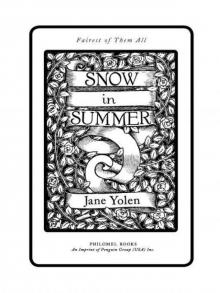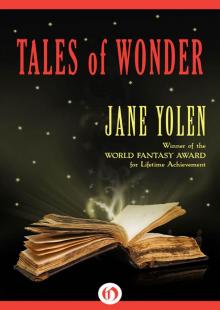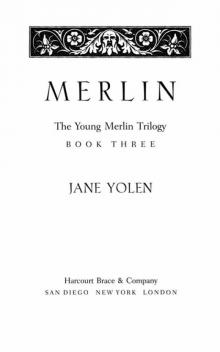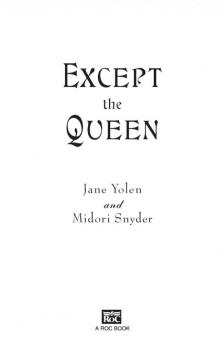- Home
- Jane Yolen
Tales of Wonder
Tales of Wonder Read online
EARLY BIRD BOOKS
FRESH EBOOK DEALS, DELIVERED DAILY
BE THE FIRST TO KNOW—
NEW DEALS HATCH EVERY DAY!
Tales of Wonder
Jane Yolen
All these tales—and more—
are for David
and my favorite tellers:
Connie and Barbara, Laura, and Carol
Contents
Introduction: The Bright Ring of Words
The Pot Child
Sun/Flight
The Moon Ribbon
The Gwynhfar
The Sleep of Trees
Boris Chernevsky’s Hands
In the Hall of Grief
Cards of Grief
Old Herald
Sule Skerry
The White Seal Maid
The Bird of Time
The Weaver of Tomorrow
The Boy Who Sang for Death
The Lady and the Merman
Wild Goose and Gander
The Boy Who Had Wings
The Girl Who Loved the Wind
Brothers of the Wind
The Golden Balls
Johanna
The Sow, the Mare, and the Cow
Cockfight
Brother Kenan’s Bell
Sans Soleil
The Seventh Mandarin
The Soul Fisher
One Old Man, with Seals
Names
Sister Light, Sister Dark
A Personal History by Jane Yolen
Introduction The Bright Ring of Words
I am a Storyteller who tells onto the printed page and often find myself recalling Montaigne’s poignant phrase “We are, I know not how, double in ourselves.” For the maker of literary fairy stories is both a part of and apart from the great tradition of Story. Most successful when invisible, the author of such tales should be anonymous. Yet my stories are written not by Anon, that centuries-old master of many forms, but by a particular twentieth-century eclectic mythologizer (horrid word) living in America, in New England, surrounded by children, an Apple computer, cable TV, a nearby McDonald’s—in fact all the accoutrements of modern life.
There is a charming verse by Robert Louis Stevenson that begins:
Bright is the ring of words
When the right man rings them,
Fair the fall of songs
When the singer sings them.
Still they are carolled and said,
On wings they are carried
After the singer is dead
And the maker buried.
And that same sentiment was reiterated to me by a young correspondent who wrote: “Your tales will live forever. I hope you live to 99 or 100, but who cares.” Who cares, indeed. Outside of my own family and friends, it is not the “I” who matters but the tales told on the page. If they can then leap from the page onto the lips of a dedicated oral teller and live on, kept alive by the folk process of mouth-to-mouth resuscitation, that is glory indeed.
For any storyteller there are two starting places for a tale. One is physical, touchable, knowable, and immediate. The other lies deep in the hidden recesses of the heart. Often years stretch between the two starting places, and the author feels like a weary traveler trudging through an unknown landscape with a tatter of map clutched in a desiccated hand. Suddenly the map matches a place, the squiggles of line translate into a river or a mountain, a moment in map time becomes a meeting. A story begins.
The Japanese have a word for it: saku-taku-no-ki.
Saku—the special sound a mother hen makes tapping on the egg with her beak.
Taku—the sound the chick makes tapping from within.
No-ki—the moment when the tappings come together.
Saku-taku-no-ki is the instant when the chick pecking on the inside of the egg and its mother pecking on the outside reach the same spot. The egg cracks open. New life emerges. In just that way a story begins, with the physical tapping on the outside and the answering emotion tapping from within.
After the story emerges—sometimes long afterward—one can chart its course. For example, “Names” began when I met a woman whose mother had survived Dachau. This woman was on such a severe diet that she had lost forty pounds in two months and looked, according to her husband, like a concentration-camp victim. Though the irony seemed lost on her, it was not lost on me. Yet the story is not about the woman, whom I scarcely knew. It is about me, for it was written at a time when I was struggling with my teenage daughter who was feeling bowed under by the weight of my “name” as a writer. Still, I hope the story is now about neither the dieting woman or me but about Rachel Zuckerman, the girl in the tale. Similarly, “The Lady and the Merman” had its ostensible beginning at a poetry reading where a young man read a very bad poem about the ocean washing away words he had written in the sand. At that time I was immersed in research about the legends and lore of the Mer, the underwater seafolk. But the tale is about my relationship with my own father, though the woman, Borne, solves her problem in a way I would not.
Saku-taku-no-ki.
The tale, then, is both a map of the human psyche who began it and a map of the characters within. But a story needs more than an author. It needs a reader as well before it is complete. Often I receive mail from readers who have found in one story or another of mine their own “tale of the heart.” That is when I know I have succeeded.
In fact, I most often describe the tales I write as “tales of the heart.” They are not old stories retold, straight from the folk, a direct link with the oral tradition, copyrighted in my name. Nor are they modern variants on an old tale, transcribed and branded mine in the manner of a Charles Perrault or a Madame Le Prince de Beaumont. Rather they are stories of my own devising—biography mixed with dream, real life crossed with visions—lent tone and style by a conscious and unconscious remembering of folk rhythms which I have come to by prodigious readings of old stories and singings of ballads and come-all-ye’s and cante-fables. If Jungian archetypes inform them as well, so be it. If modern science fiction has lent occasional substance, I am guilty of that, too. There is an eclecticism to modern telling. Stories lean on stories, art on art. I can only trace my own sources so far before I realize that, in the end, it is the story that matters, not the parts: the tapestry of tale and not the individual threads. And just as kings and dragons and the Mer-folk swimming through the murmurations of the sea do not necessarily signal the old, so one cannot sum up all of modernity with a computer chip.
In a world of cable television and video arcades, I write about magical things because, like Emily Dickinson, “I dwell in possibility.” I tell tales of transformations and transfigurations knowing that I use folk metaphor as a kind of literary shorthand—at times. But there is something more. I would like to believe that there is that of faerie in each of us, a little trickle or stream that, if we could but tap it, would lead us back to the great wellspring of magic we share with every human being, every creature—and the world.
JANE YOLEN
Phoenix Farm
Hatfield, Massachusetts
The Pot Child
There was once an ill-humored potter who lived all alone and made his way by shaping clay into cups and bowls and urns. His pots were colored with the tones of the earth, and on their sides he painted all creatures excepting man.
“For there was never a human I liked well enough to share my house and my life with,” said the bitter old man.
But one day, when the potter was known throughout the land for his sharp tongue as well as his pots, and so old that even death might have come as a friend, he sat down and on the side of a large bisque urn he drew a child.
The child was without flaw in the outline, and so the potter colored in its form with earth gla
zes: rutile for the body and cobalt blue for the eyes. And to the potter’s practiced eye, the figure on the pot was perfect.
So he put the pot into the kiln, closed up the door with bricks, and set the flame.
Slowly the fires burned. And within the kiln the glazes matured and turned their proper tones.
It was a full day and a night before the firing was done. And a full day and a night before the kiln had cooled. And it was a full day and a night before the old potter dared unbrick the kiln door. For the pot child was his masterpiece, of this he was sure.
At last, though, he could put it off no longer. He took down the kiln door, reached in, and removed the urn.
Slowly he felt along the pot’s side. It was smooth and still warm. He set the pot on the ground and walked around it, nodding his head as he went.
The child on the pot was so lifelike, it seemed to follow him with its lapis eyes. Its skin was a pearly yellow-white, and each hair on its head like beaten gold.
So the old potter squatted down before the urn, examining the figure closely, checking it for cracks and flaws, but there were none. He drew in his breath at the child’s beauty and thought to himself, “There is one I might like well enough.” And when he expelled his breath again, he blew directly on the image’s lips.
At that, the pot child sighed and stepped off the urn.
This so startled the old man that he fell back into the dust.
After a while, though, the potter saw that the pot child was waiting for him to speak. So he stood up and in a brusque tone said, “Well, then, come here. Let me look at you.”
The child ran over to him and, ignoring his tone, put its arms around his waist and whispered, “Father,” in a high sweet voice.
This so startled the old man that he was speechless for the first time in his life. And as he could not find the words to tell the child to go, it stayed. Yet after a day, when he had found the words, the potter knew he could not utter them, for the child’s perfect face and figure had enchanted him.
When the potter worked or ate or slept, the child was by his side, speaking when spoken to but otherwise still. It was a pot child, after all, and not a real child. It did not join him in his work but was content to watch. When other people came to the old man’s shop, the child stepped back onto the urn and did not move. Only the potter knew it was alive.
One day several famous people came to the potter’s shop. He showed them all around, grudgingly, touching one pot and then another. He answered their questions in a voice that was crusty and hard. But they knew his reputation and did not answer back.
At last they came to the urn.
The old man stood before it and sighed. It was such an uncharacteristic sound that the people looked at him strangely. But the potter did not notice. He simply stood for a moment more, then said, “This is the Pot Child. It is my masterpiece. I shall never make another one so fine.”
He moved away, and one woman said after him, “It is good.” But turning to her companions, she added in a low voice, “But it is too perfect for me.”
A man with her agreed. “It lacks something,” he whispered back.
The woman thought a moment. “It has no heart,” she said. “That is what is wrong.”
“It has no soul,” he amended.
They nodded at each other and turned away from the urn. The woman picked out several small bowls, and, paying for them, she and the others went away.
No sooner were the people out of sight than the pot child stepped down from the urn.
“Father,” the pot child asked, “what is a heart?”
“A vastly overrated part of the body,” said the old man gruffly. He turned to work the clay on his wheel.
“Then,” thought the pot child, “I am better off without one.” It watched as the clay grew first tall and then wide between the potter’s knowing palms. It hesitated asking another question, but at last could bear it no longer.
“And what is a soul, Father?” said the pot child. “Why did you not draw one on me when you made me on the urn?”
The potter looked up in surprise. “Draw one? No one can draw a soul.”
The child’s disappointment was so profound, the potter added, “A man’s body is like a pot, which does not disclose what is inside. Only when the pot is poured, do we see its contents. Only when a man acts, do we know what kind of soul he has.”
The pot child seemed happy with that explanation, and the potter went back to his work. But over the next few weeks the child continually got in his way. When the potter worked the clay, the pot child tried to bring him water to keep the clay moist. But it spilled the water, and the potter pushed the child away.
When the potter carried the unfired pots to the kiln, the pot child tried to carry some, too. But it dropped the pots, and many were shattered. The potter started to cry out in anger, bit his tongue, and was still.
When the potter went to fire the kiln, the pot child tried to light the flame. Instead, it blew out the fire.
At last the potter cried, “You heartless thing. Leave me to do my work. It is all I have. How am I to keep body and soul together when I am so plagued by you?”
At these words, the pot child sat down in the dirt, covered its face, and wept. Its tiny body heaved so with its sobs that the potter feared it would break in two. His crusty old heart softened, and he went over to the pot child and said, “There, child. I did not mean to shout so. What is it that ails you?”
The pot child looked up. “Oh, my father, I know I have no heart. But that is a vastly overrated part of the body. Still, I was trying to show how I was growing a soul.”
The old man looked startled for a minute, but then, recalling their conversation of many weeks before, he said, “My poor pot child, no one can grow a soul. It is there from birth.” He touched the child lightly on the head.
The potter had meant to console the child, but at that the child cried even harder than before. Drops sprang from its eyes and ran down its cheeks like blue glaze. “Then I shall never have a soul,” the pot child cried. “For I was not born but made.”
Seeing how the child suffered, the old man took a deep breath. And when he let it out again, he said, “Child, as I made you, now I will make you a promise. When I die, you shall have my soul, for then I shall no longer need it.”
“Oh, then I will be truly happy,” said the pot child, slipping its little hand gratefully into the old man’s. It did not see the look of pain that crossed the old man’s face. But when it looked up at him and smiled, the old man could not help but smile back.
That very night, under the watchful eyes of the pot child, the potter wrote out his will. It was a simple paper, but it took a long time to compose, for words did not come easily to the old man. Yet as he wrote, he felt surprisingly lightened. And the pot child smiled at him all the while. At last, after many scratchings out, it was done. The potter read the paper aloud to the pot child.
“It is good,” said the pot child. “You do not suppose I will have long to wait for my soul?”
The old man laughed. “Not long, child.”
And then the old man slept, tired after the late night’s labor. But he had been so busy writing, he had forgotten to bank his fire, and in the darkest part of the night, the flames went out.
In the morning the shop was ice cold, and so was the old man. He did not waken, and without him the pot child could not move from its shelf.
Later in the day, when the first customers arrived, they found the old man. And beneath his cold fingers lay a piece of paper that said:
When I am dead, place my body in my kiln and light the flames. And when I am nothing but ashes, let those ashes be placed inside the Pot Child. For I would be one, body and soul, with the earth I have worked.
So it was done as the potter wished. And when the kiln was opened up, the people of the town placed the ashes in the ice-cold urn.
At the touch of the hot ashes, the pot cracked: once across the breast of the chi
ld, and two small fissures under its eyes.
“What a shame,” said the people to one another on seeing that. “We should have waited until the ashes cooled.”
Yet the pot was still so beautiful, and the old potter so well known, that the urn was placed at once in a museum. Many people came to gaze on it.
One of those was the woman who had seen the pot that day so long ago at the shop.
“Why, look,” she said to her companions. “It is the pot the old man called his masterpiece. It is good. But I like it even better now with those small cracks.”
“Yes,” said one of her companions, “it was too perfect before.”
“Now the pot child has real character” said the woman. “It has … heart.”
“Yes,” added the same companion, “it has soul.”
And they spoke so loudly that all the people around them heard. The story of their conversation was printed and repeated throughout the land, and everyone who went by the pot stopped and murmured, as if part of a ritual, “Look at that pot child. It has such heart. It has such soul.”
Sun/Flight
They call me the nameless one. My mother was the sea, and the sun itself fathered me. I was born fully clothed, and on my boyish cheeks was the beginnings of a beard. Whoever I was, wherever I came from, had been washed from me by the waves in which I was found.
And so I have made many pasts for myself. A honey-colored mother cradling me. A father with his beard short and shaped like a Minoan spade. Sisters and brothers have I gifted myself. And a home that smelled of fresh-strewn reeds and olives ripening on the trees. Sometimes I make myself a king’s son, godborn, a javelin in my hand and a smear of honeycake on my lips. Other times I am a craftsman’s child, with a length of golden string threaded around my thumbs. Or the son of a dmos, a serf, my back bent over the furrows where little birds search for seeds like farmers counting the crop. With no remembered pasts, I can pick a different one each day to suit my mood, to cater to my need.
But most of the time I think myself the child of the birds, for when the fishermen pulled me up from the sea, drowned of my past, I clutched a single feather in my hand. The feather was golden—sun-colored—and when it dried it was tufted with yellow rays. I carried it with me always, my talisman, my token back across the Styx. No one knew what bird had carried this feather in its wing or tail. The shaft is strong and white, and the barbs soft. The little fingers of down are no color at all; they change with the changing light.

 The Pictish Child
The Pictish Child Cards of Grief
Cards of Grief A Plague of Unicorns
A Plague of Unicorns Heart's Blood
Heart's Blood Mapping the Bones
Mapping the Bones Snow in Summer
Snow in Summer Merlin's Booke: Stories of the Great Wizard
Merlin's Booke: Stories of the Great Wizard Centaur Rising
Centaur Rising The One-Armed Queen
The One-Armed Queen Dragon's Blood
Dragon's Blood Boots and the Seven Leaguers
Boots and the Seven Leaguers The Girl Who Cried Flowers and Other Tales
The Girl Who Cried Flowers and Other Tales The Wizard of Washington Square
The Wizard of Washington Square Tales of Wonder
Tales of Wonder The Emerald Circus
The Emerald Circus Sister Light, Sister Dark
Sister Light, Sister Dark Twelve Impossible Things Before Breakfast
Twelve Impossible Things Before Breakfast The Devil's Arithmetic
The Devil's Arithmetic Trash Mountain
Trash Mountain The Dragon's Boy
The Dragon's Boy A Sending of Dragons
A Sending of Dragons The Young Merlin Trilogy
The Young Merlin Trilogy The Last Tsar's Dragons
The Last Tsar's Dragons Curse of the Thirteenth Fey: The True Tale of Sleeping Beauty
Curse of the Thirteenth Fey: The True Tale of Sleeping Beauty The Bagpiper's Ghost
The Bagpiper's Ghost Nebula Awards Showcase 2018
Nebula Awards Showcase 2018 Hobby
Hobby How to Fracture a Fairy Tale: 2
How to Fracture a Fairy Tale: 2 Children of a Different Sky
Children of a Different Sky Commander Toad and the Intergalactic Spy
Commander Toad and the Intergalactic Spy Wizard’s Hall
Wizard’s Hall The Transfigured Hart
The Transfigured Hart Dragonfield: And Other Stories
Dragonfield: And Other Stories The Magic Three of Solatia
The Magic Three of Solatia The Great Alta Saga Omnibus
The Great Alta Saga Omnibus Favorite Folktales From Around the World
Favorite Folktales From Around the World Passager
Passager The Wizard's Map
The Wizard's Map The Last Changeling
The Last Changeling Except the Queen
Except the Queen Snow in Summer: Fairest of Them All: Fairest of Them All
Snow in Summer: Fairest of Them All: Fairest of Them All The Midnight Circus
The Midnight Circus Atalanta and the Arcadian Beast
Atalanta and the Arcadian Beast Finding Baba Yaga
Finding Baba Yaga The Rogues
The Rogues Dragon's Boy
Dragon's Boy The Hostage Prince
The Hostage Prince Wizard of Washington Square
Wizard of Washington Square How to Fracture a Fairy Tale
How to Fracture a Fairy Tale Magic Three of Solatia
Magic Three of Solatia Curse of the Thirteenth Fey
Curse of the Thirteenth Fey My Brothers' Flying Machine
My Brothers' Flying Machine Not One Damsel in Distress
Not One Damsel in Distress Merlin's Booke
Merlin's Booke Pay the Piper: A Rock 'n' Roll Fairy Tale
Pay the Piper: A Rock 'n' Roll Fairy Tale Merlin
Merlin Troll Bridge
Troll Bridge Pay the Piper
Pay the Piper Dragonfield
Dragonfield Sister Emily's Lightship
Sister Emily's Lightship Hippolyta and the Curse of the Amazons
Hippolyta and the Curse of the Amazons Prince Across the Water
Prince Across the Water Dragon's Heart
Dragon's Heart The Seelie King's War
The Seelie King's War Among Angels
Among Angels Queen's Own Fool
Queen's Own Fool